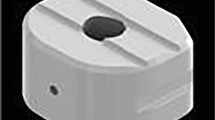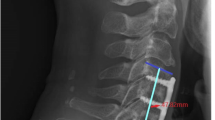Abstract
Introduction: Intervertebral carbon fiber cages may reduce graft collapse and promote bony fusion. Their safety and efficacy in the cervical spine have been investigated; however, no study has compared the outcomes of anterior cervical decompression and placement of a carbon fiber cage with placement of allograft and plate. Methods: Forty consecutive patients who met inclusion criteria were enrolled and randomized to anterior cervical discectomy with carbon fiber cage alone (n=20) or with allograft with plating (n=20). Clinical and radiographic evaluations were performed at baseline and at 6 weeks, 3, 6, 12 and 24 months. Neck and arm pain as well as neck disability index (NDI) were assessed at every visit. The Short Form (SF)-36 was completed prior to operation and at 12-month intervals. Cervical radiographs were evaluated pre-op and at every follow-up for evidence of fusion and instability. Results: No significant difference was found between the two randomized groups with respect to pre-operative age (mean 50 years), sex, employment status, duration of pain or cervical levels affected. The mean follow-up period was 14 months (range, 6–26 months). The clinical pain and disability improvements were similar for both treatments. Post-operative donor site pain was only present in the cage group, but not of significant long-term disability. At up to 24 months, NDI scores were significantly improved in both groups when compared with baseline. At 12 and 24 months, all SF-36 questionnaire responses were also improved in both the treatment groups. However, there was no statistically significant difference in outcomes between the two groups at any time. The fusion rate was 100% in both groups by 12 and 24 months, without evidence of instability. There were no differences in complications between both groups. Conclusions: The outcomes after cervical decompression and placement of a carbon fiber cage appear to be similar to cervical decompression with allograft and plating by the Smith–Robinson technique.



Similar content being viewed by others
References
Agrillo U, Mastronardi L, Puzzilli F (2002) Anterior cervical fusion with carbon fiber cage containing coralline hydroxyapatite: preliminary observations in 45 consecutive cases of soft-disc herniation. J Neurosurg 96:273–276
Banco SP, Jenis L, Tromanhauser S, Rand F, Banco RJ (2002) The use of cervical cages for treatment of cervical disc disease. Curr Opin Orthop 13:220–223
Banwart JC, Asher MA, Hassanein RS (1995) Iliac crest bone graft harvest donor site morbidity. A statistical evaluation. Spine 20:1055–1060
Bartels RH, Donk R, van Azn RD (2001) Height of cervical foramina after anterior discectomy and implantation of a carbon fiber cage. J Neurosurg 95:40–42
Bishop RC, Moore KA, Hadley MN (1996) Anterior cervical interbody fusion using autogeneic and allogeneic bone graft substrate: a prospective comparative analysis. J Neurosurg 85:206–210
Bose B (2001) Anterior cervical instrumentation enhances fusion rates in multilevel reconstruction in smokers. J Spinal Disord 14:3–9
Brantigan JW, Steffee AD, Geiger JM (1991) A carbon fiber implant to aid interbody lumbar fusion. Mechanical testing. Spine 16:S277–S282
Brodke DS, Dick JC, Kunz DN, McCabe R, Zdeblick TA (1997) Posterior lumbar interbody fusion. A biomechanical comparison, including a new threaded cage. Spine 22:26–31
Brooke NS, Rorke AW, King AT, Gullan RW (1997) Preliminary experience of carbon fibre cage prostheses for treatment of cervical spine disorders. Br J Neurosurg 11:221–227
Cauthen JC, Kinard RE, Vogler JB, Jackson DE, DePaz OB, Hunter OL et al (1998) Outcome analysis of noninstrumented anterior cervical discectomy and interbody fusion in 348 patients. Spine 23:188–192
Cloward RB (1958) The anterior approach for removal of ruptured cervical disks. J Neurosurg 15:602–617
Fernyhough JC, White JI, LaRocca H (1991) Fusion rates in multilevel cervical spondylosis comparing allograft fibula with autograft fibula in 126 patients. Spine 16:S561–S564
Floyd T, Ohnmeiss D (2000) A meta-analysis of autograft versus allograft in anterior cervical fusion. Eur Spine J 9:398–403
Hacker RJ, Cauthen JC, Gilbert TJ, Griffith SL (2000) A prospective randomized multicenter clinical evaluation of an anterior cervical fusion cage (discussion 2655). Spine 25:2646–2654
Kandziora F, Pflugmacher R, Schafer J, Born C, Duda G, Haas NP et al (2001) Biomechanical comparison of cervical spine interbody fusion cages. Spine 26:1850–1857
Kettler A, Wilke HJ, Claes L (2001) Effects of neck movements on stability and subsidence in cervical interbody fusion: an in vitro study. J Neurosurg 94:97–107
Majd ME, Vadhva M, Holt RT (1999) Anterior cervical reconstruction using titanium cages with anterior plating. Spine 24:1604–1610
Payer M, May D, Reverdin A, Tessitore E (2003) Implantation of an empty carbon fiber composite frame cage after single-level anterior cervical discectomy in the treatment of cervical disc herniation: preliminary results. J Neurosurg 98:143–148
Salame K, Ouaknine GER, Razon N, Rochkind S (2002) The use of carbon fiber cages in anterior cervical interbody fusion: report of 100 cases. Neurosurg Focus 12:Article 1
Sawin PD, Traynelis VC, Menezes AH (1998) A comparative analysis of fusion rates and donor-site morbidity for autogeneic rib and iliac crest bone grafts in posterior cervical fusions. J Neurosurg 88:255–265
Shono Y, McAfee PC, Cunningham BW, Brantigan JW (1993) A biomechanical analysis of decompression and reconstruction methods in the cervical spine. Emphasis on a carbon-fiber-composite cage. J Bone Joint Surg Am 75:1674–1684
Siddiqui AA, Jackowski A (2003) Cage versus tricortical graft for cervical interbody fusion. A prospective randomised study. J Bone Joint Surg Br 85:1019–1025
Smith GW, Robinson RA (1958) The treatment of certain cervical-spine disorders by anterior removal of the intervertebral disc and interbody fusion. J Bone Joint Surg Am 40-A:607–624
Summers BN, Eisenstein SM (1989) Donor site pain from the ilium. A complication of lumbar spine fusion. J Bone Joint Surg Br 71:677–680
Tancredi A, Agrillo A, Delfini R, Fiume D, Frati A, Rinaldi A (2004) Use of carbon fiber cages for treatment of cervical myeloradiculopathies (discussion 226). Surg Neurol 61:221–6
Togawa D, Bauer TW, Brantigan JW, Lowery GL (2001) Bone graft incorporation in radiographically successful human intervertebral body fusion cages. Spine 26:2744–1750
Vavruch L, Hedlund R, Javid D, Leszniewski W, Shalabi A (2002) A prospective randomized comparison between the cloward procedure and a carbon fiber cage in the cervical spine: a clinical and radiologic study. Spine 27:1694–1701
Wilke HJ, Kettler A, Claes L (2000) Primary stabilizing effect of interbody fusion devices for the cervical spine: an in vitro comparison between three different cage types and bone cement. Eur Spine J 9:410–416
Author information
Authors and Affiliations
Corresponding author
Rights and permissions
About this article
Cite this article
Ryu, S.I., Mitchell, M. & Kim, D.H. A prospective randomized study comparing a cervical carbon fiber cage to the Smith–Robinson technique with allograft and plating: up to 24 months follow-up. Eur Spine J 15, 157–164 (2006). https://doi.org/10.1007/s00586-005-0951-1
Received:
Revised:
Accepted:
Published:
Issue Date:
DOI: https://doi.org/10.1007/s00586-005-0951-1




